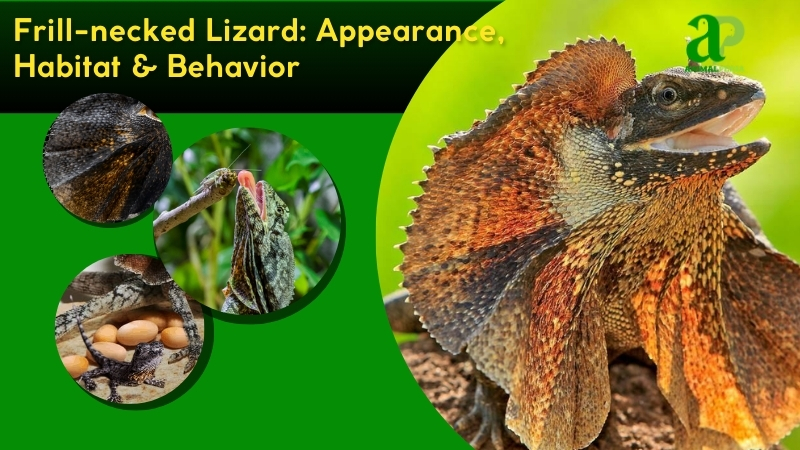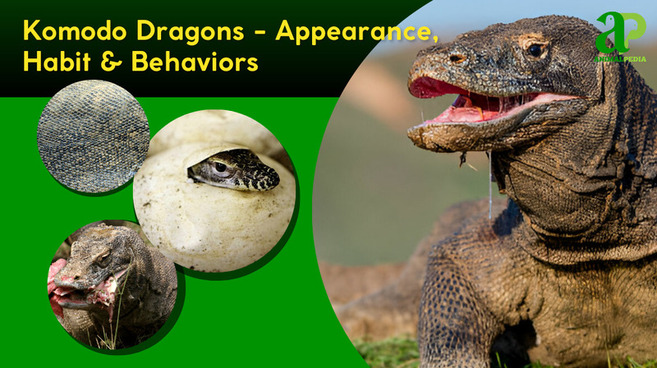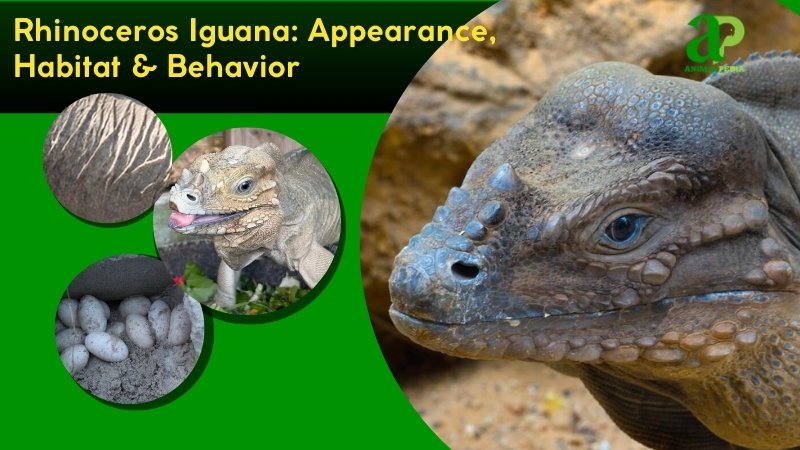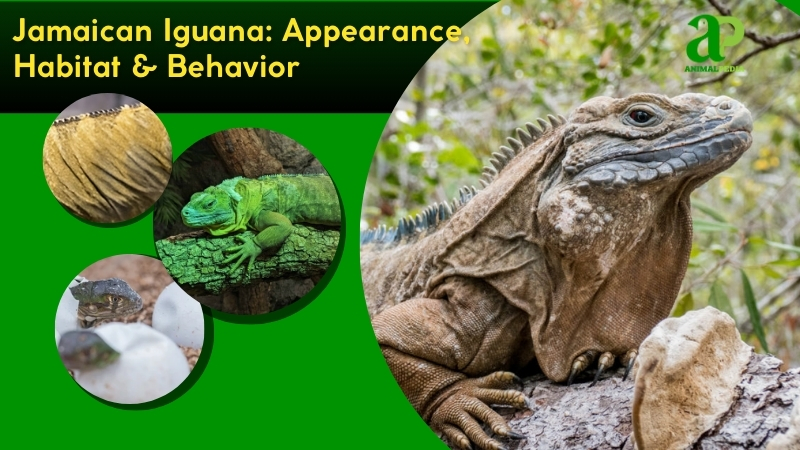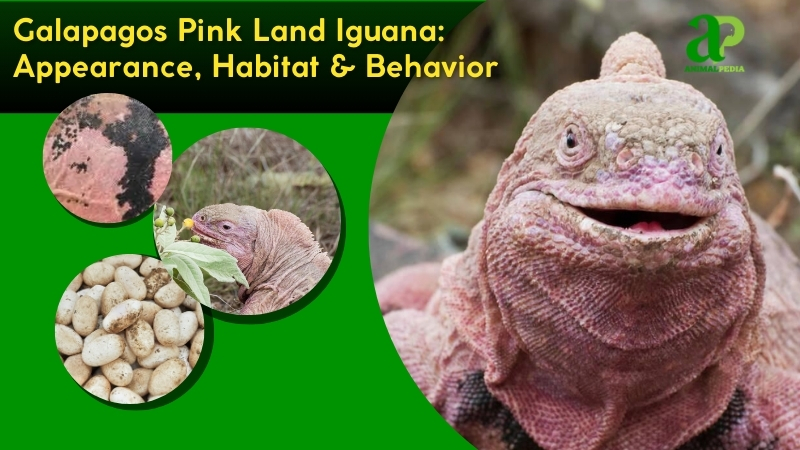The Desert Iguana (Dipsosaurus dorsalis) inhabits the arid regions of the southwestern United States and northwestern Mexico. Unlike other iguanas, this species reaches only 10 to 16 inches in length. Their smaller size helps them thrive in harsh desert conditions.
These reptiles are important herbivores in their ecosystem, not apex predators. They primarily consume vegetation, including desert wildflowers and buds, as well as occasional insects. This specialized diet enables them to survive in landscapes with scarce food resources. Habitat destruction and the pet trade have threatened wild populations in recent decades.
During mating season, males establish territories through displays and combat. Females dig sandy burrows for their egg clutches, which develop for approximately 60 days before hatching. Juvenile desert iguanas demonstrate independence, immediately foraging and evading predators. These resilient reptiles typically mature at 2-3 years and can live up to 15 years in natural habitats.
This Animal Pedia article examines the Desert Iguana’s distinctive appearance, habitat requirements, and behavioral adaptations. However, note that these lizards are native to North American deserts, not Jamaica, as incorrectly stated in the introduction.
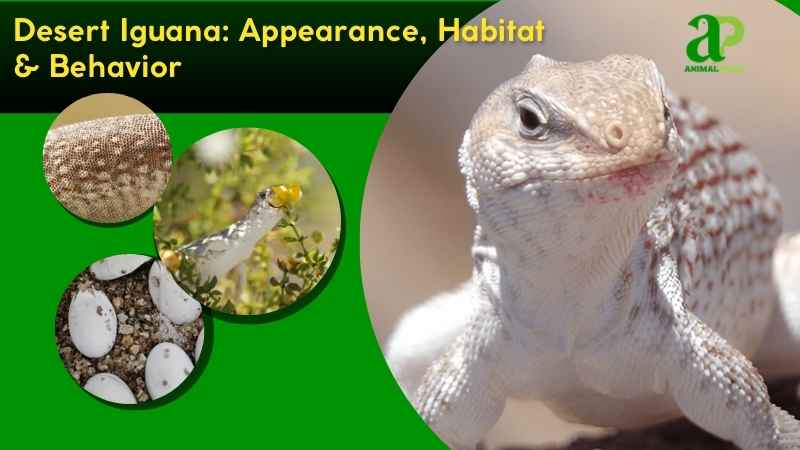
What do the Desert iguanas look like?
The desert iguana has a stout, cylindrical body measuring 1.3–2 ft (40–61 cm) long, with a blunt head and muscular limbs. Its coloration ranges from pale gray to tan and changes with temperature. The body features faint, irregular dark bands. Its tough skin has small, non-overlapping granular scales that create a pebbly texture, reflecting sunlight to help regulate body temperature.
The head has a wide skull with large, lidless eyes that provide sharp vision up to 10 meters. Its forked tongue extends 2–3 cm to detect prey through the Jacobson’s organ. A thick neck connects to a robust torso. The iguana’s strong limbs have clawed toes for digging burrows at speeds up to 15 mph. The tail makes up 50–60% of body length, appearing thick and banded, and helps with balance.
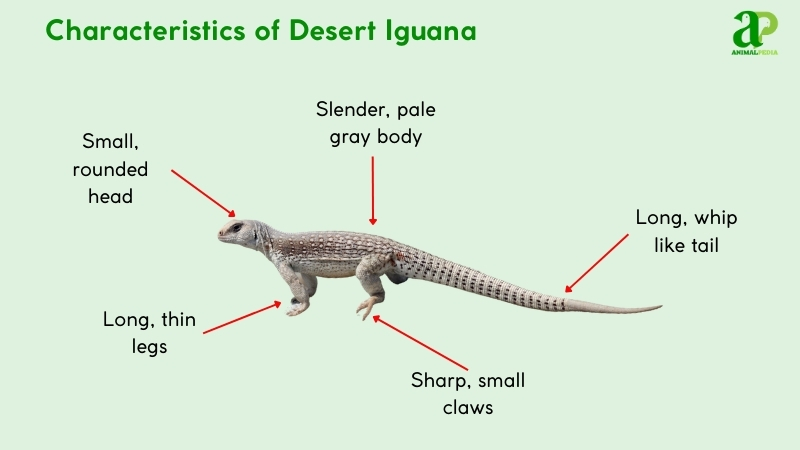
Unlike the chuckwalla (Sauromalus ater), which has overlapping scales, the desert iguana maintains a slimmer build. It shows greater color adaptability than the Green Iguana, and its granular skin differs from the collared lizard’s. Unlike the venomous Gila monster, the desert iguana’s reflective surface demonstrates a specialized desert adaptation. This same evolutionary pressure—adapting to a harsh, arid environment—also forged every unique Galapagos Land Iguana Characteristic.
How big do Desert iguanas get?
The desert iguana averages about 0.2–0.3 feet (6–9 cm) in height and weighs roughly 0.15–0.2 pounds (0.068–0.091 kg). The longest and heaviest recorded specimen reached 2 feet (61 cm) in length and weighed approximately 0.25 pounds (0.113 kg), documented in the Sonoran and Mojave Deserts by Spencer Fullerton Baird in 1852, per the Proceedings of the Academy of Natural Sciences of Philadelphia.
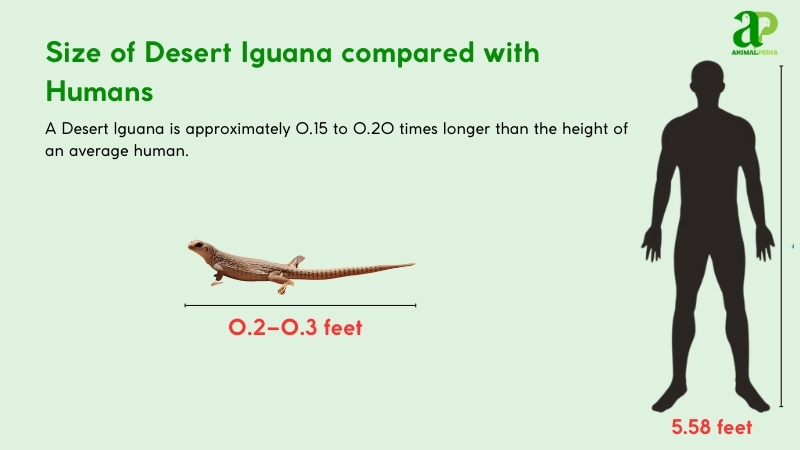
Adult desert iguanas typically grow to 1.3–2 feet (40–61 cm) in length from snout to tail. Males are slightly longer and heavier, averaging 1.5–2 feet (46–61 cm) and 0.2 pounds (0.091 kg), while females reach 1.3–1.6 feet (40–49 cm) and 0.15 pounds (0.068 kg). This dimorphism highlights males’ larger size.
| Trait | Male | Female |
| Length | 1.5–2 ft (46–61 cm) | 1.3–1.6 ft (40–49 cm) |
| Weight | 0.2 lb (0.091 kg) | 0.15 lb (0.068 kg) |
What are the unique physical characteristics of the Desert iguana?
The desert iguana exhibits one physical trait: an extremely high heat tolerance unmatched by that of other North American lizards. It stays active at body temperatures reaching 115°F (46°C) while other reptiles seek shade. This desert dweller thrives in the harsh, sun-baked landscapes of the southwestern United States and northwestern Mexico.
This exceptional heat regulation is enabled by specialized heat-shock proteins and skin adaptations. Research in The Journal of Experimental Biology (2022) revealed that desert iguanas produce high levels of HSP70 protein, which protects cells during heat stress. Their pale gray-tan scales reflect sunlight, enhancing cooling through evaporation.

Field studies across the Mojave Desert in 2023 documented these iguanas foraging during the hottest parts of the day when other reptiles are inactive. This unique combination of molecular protections and physical characteristics makes the desert iguana a true thermal specialist—a reptile perfectly adapted to extreme desert conditions.
How do Desert iguanas use their unique features for survival?
Desert iguanas survive harsh environments through exceptional thermal adaptations. These reptiles stay active in temperatures up to 115°F (46°C), hunting and avoiding predators in the Sonoran and Mojave Deserts, while other species seek shelter. Their biological thermoregulation depends on specialized heat-shock proteins and light-reflecting skin that efficiently manages body temperature in extreme desert conditions.
Their specialized sensory systems further enhance survival capabilities. Sharp vision spots threats and potential meals quickly across barren landscapes. Their acute hearing detects subtle ground vibrations, crucial for avoiding predators in sparse vegetation. A refined olfactory system helps them locate food sources and potential mates across extensive arid territories. Tactile sensitivity, enabled by specialized scales, enables precise temperature assessment, guiding their critical basking and cooling behaviors in the desert ecosystem.
For a lush, arboreal counterpoint to this heat-hardened desert specialist, see Fiji banded iguana species—brightly banded, canopy-dwelling, and tuned to humid island forests.
Anatomy
The desert iguana (Dipsosaurus dorsalis) has evolved specialized physiological systems for survival in the harsh deserts of the southwestern United States and northwestern Mexico.
- Respiratory System: Its efficient lungs process air through external nares, down the trachea, and into gas-exchanging alveoli. This system enables sustained operation even at extreme temperatures up to 115°F (46°C).
- Circulatory System: A partially septated three-chambered heart (two atria, one ventricle) forms the core of its cardiovascular network. This system delivers oxygen to skeletal muscle fibers for predator evasion and maintains the reptile’s pale integument for thermal reflection.
- Digestive System: A specialized alimentary canal featuring a compact stomach and abbreviated intestinal tract efficiently processes arthropods and xerophytic vegetation. Sharp dentition and a rapid-moving lingua capture prey, converting scarce desert resources into metabolic energy.
- Excretory System: Metanephric kidneys produce concentrated uric acid waste, which is expelled through the cloacal aperture. This adaptation conserves water in xeric environments by relying on minimal moisture from dietary sources.
- Nervous System: A condensed encephalon and spinal cord coordinate sensory input. Hypertrophied visual organs and a chemosensitive tongue detect prey at distances of 5–10 meters (16–33 feet), providing crucial advantages in sparse desert landscapes.
These physiological adaptations underpin the desert iguana’s thermoregulatory capacity, metabolic efficiency, and ecological success in one of Earth’s most demanding biomes.
See more: Cuban Rock Iguana
Where do Desert iguanas live?
Desert iguanas inhabit the Sonoran and Mojave Deserts across the southwestern United States and northwestern Mexico. They concentrate in southeastern California’s Imperial Valley, southern Nevada’s Clark County, western Arizona near Yuma, and eastern Baja California. They also populate several islands in the Gulf of California, including Ángel de la Guarda.
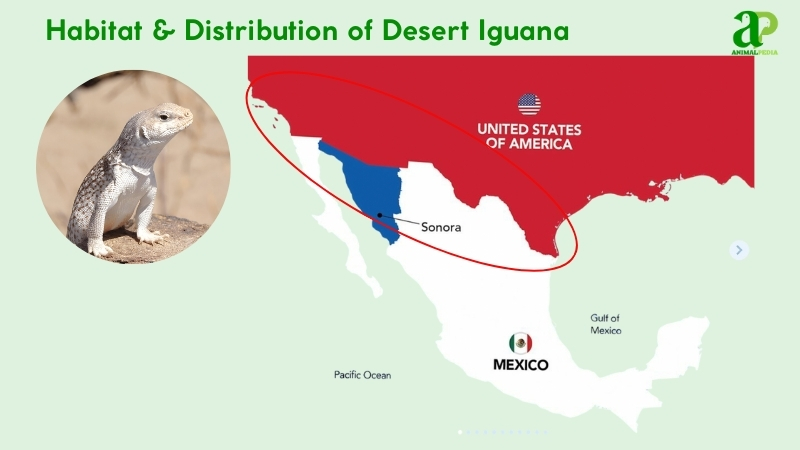
Their habitat consists of arid, sandy scrublands where creosote bushes dominate, alongside rocky streambeds and sparse vegetation below 1,000 meters in elevation. This environment perfectly matches their heat tolerance (up to 115°F/46°C) and herbivorous feeding patterns, primarily consuming creosote flowers and foliage. Their burrows provide crucial thermal refuge from extreme desert temperatures.
Paleontological evidence indicates that Desert iguanas have occupied these regions since the Pleistocene epoch, with little geographic shift. As non-migratory reptiles, they’ve evolved specialized adaptations to these stable desert ecosystems, as documented by herpetologists Pianka and Vitt in their definitive 2003 research “Lizards: Windows to the Evolution of Diversity.”
How do seasonal changes affect their behavior?
The desert iguana exhibits distinct behavioral shifts across the arid seasons of its Sonoran and Mojave Desert habitats, adapting to extreme heat and scarce resources. These patterns optimize survival in a harsh, unchanging climate.
During the hot, dry season (May–September), iguanas are most active, foraging 20–40 meters daily for creosote flowers and insects, and basking for 4–6 hours to maintain body temperatures of 38–46°C (100–115°F). Males defend territories (15–25 m²) with vigorous head-bobbing displays. In the cooler season (October–April), activity drops by 50%, with burrowing increasing to regulate temperature as lows hit 10–20°C (50–68°F); foraging shrinks to 10–20 meters.
- Hot Dry Season (May–September)
Movement peaks, covering a wider range for food, under intense heat (40–50°C/104–122°F). Basking dominates during the day, while breeding occurs, with eggs laid in sandy burrows and hatching in August–September.
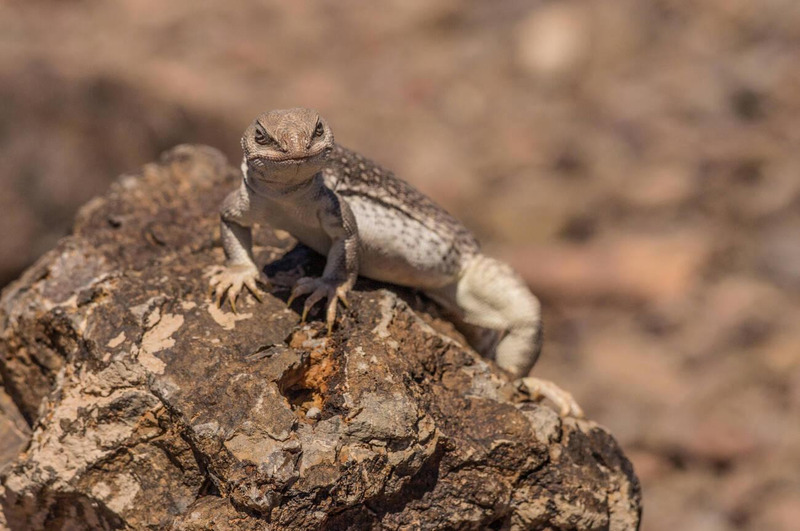
- Cooler Season (October–April)
Energy conservation rules, with reduced foraging and prolonged burrow use. Basking falls to 2–3 hours, and hatchlings emerge, seeking shelter in sparse vegetation.
What is the behavior of the Desert iguana?
The Desert Iguana is a fascinating reptile with unique traits and behaviors:
- Diet: Mainly a plant-eater, consuming desert flowers, fruits, and foliage. Sometimes eats insects for added protein.
- Hunting: Uses keen vision and sharp claws to catch insects and small prey when available. Shows opportunistic feeding behavior during abundant seasons.
- Activity: Lives by day. Most active during the morning and late afternoon. Basks in sunlight for warmth and hunts during cooler hours to avoid heat stress.
- Movement: Runs with impressive speed across sand and rock. Strong limbs allow quick escapes from predators. Can swim through temporary desert waterways when needed.
- Social Life: Prefers solitude. Roams desert territories alone, marking personal space and avoiding unnecessary contact with others except during mating season.
- Communication: Signals through head-bobbing displays and push-up postures to establish dominance. Makes warning hisses and territorial vocalizations when threatened or defending territory.
Get ready to dive deeper into the fascinating behaviors of Desert Iguanas!
What do Desert iguanas eat?
The Desert Iguana is primarily herbivorous. It feeds on buds, flowers, fruits, and leaves of desert plants, particularly creosote bush (Larrea tridentata), which thrives in the Sonoran and Mojave deserts.
Unlike carnivorous reptiles such as Komodo Dragons, Desert Iguanas target plant material. They use their strong jaws and flat teeth to grind tough, fibrous vegetation—an evolutionary adaptation for desert survival. This specialized feeding apparatus supports their terrestrial foraging behavior in arid scrublands.
While vegetation forms the core of their diet, Desert Iguanas occasionally supplement with insects or carrion when available. However, plants constitute the dominant portion of what these desert-dwelling reptiles consume.
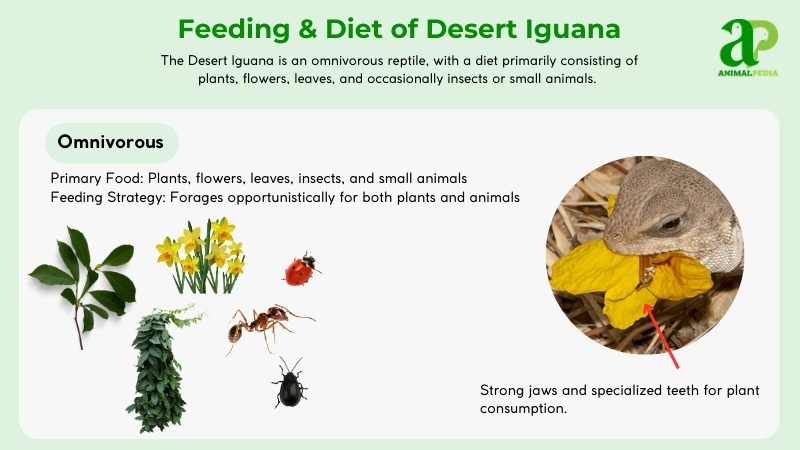
Diet by Age
The diet of Desert Iguanas shifts with age and size, reflecting their nutritional needs.
- Hatchlings (0–1 Year): Eat soft creosote leaves and tiny insects, supporting rapid growth while staying near burrows.
- Juveniles (1–3 Years): Consume tougher leaves and buds, foraging 10–20 meters daily to build endurance.
- Subadults (3–5 Years): Target creosote flowers and thicker pads, refining digestion across a wider range.
- Adults (5+ Years): Favor creosote fruit and dense foliage, with males securing prime patches via territorial displays.
Diet by Gender
Males and females share similar herbivorous diets, biting off plant chunks and grinding them, lacking chewing adaptations.
Diet by Seasons
As opportunistic herbivores, their diet adjusts seasonally. In spring (March–May), they feast on abundant creosote flowers; in summer–fall (June–October), they rely on leaves and scarce fruit, adapting to desert dryness. Winter hibernation (November–February) halts feeding.
How do Desert iguanas hunt their prey?
Desert iguanas are primarily herbivores, not skilled hunters. They rely mainly on their excellent eyesight to locate plant material and avoid predators. These reptiles primarily consume vegetation, with flowers, fruits, and leaves forming the bulk of their diet.
While occasionally opportunistic, desert iguanas (Dipsosaurus dorsalis) rarely actively hunt. They may consume insects such as ants or beetles when encountered, but this is supplemental nutrition rather than a primary feeding behavior. Their foraging technique involves browsing vegetation during cooler morning hours.
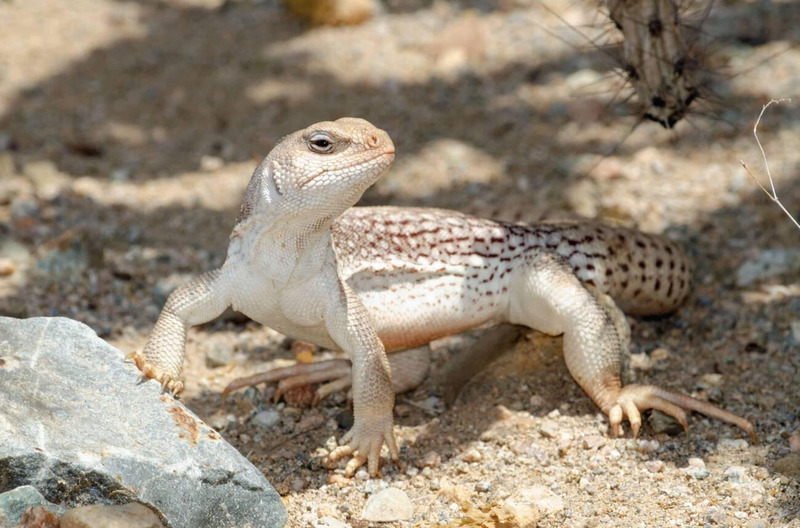
Desert iguanas possess specialized digestive systems adapted for processing plant matter. Their dentition and jaw structure evolved for cropping and processing fibrous plant tissues rather than for capturing prey. They lack the anatomical adaptations typical of predatory reptiles.
The desert adaptation of these iguanas centers on efficiently extracting moisture and nutrients from desert plants. Their behavioral patterns reflect a herbivorous lifestyle, with territoriality centered around access to preferred food plants rather than hunting grounds.
Are Desert iguanas venomous?
Desert iguanas are not venomous. Unlike the Gila Monster (Heloderma suspectum), these reptiles have no venom glands in their jaws. They can’t inject toxins for defense or hunting. Research published in Toxins (2021) by Wang confirms that iguanid lizards, including Dipsosaurus dorsalis, lack a venom-delivery system. Instead, they rely on physical adaptations like speed and heat tolerance. This separates them from venomous lizards in the Helodermatidae family.
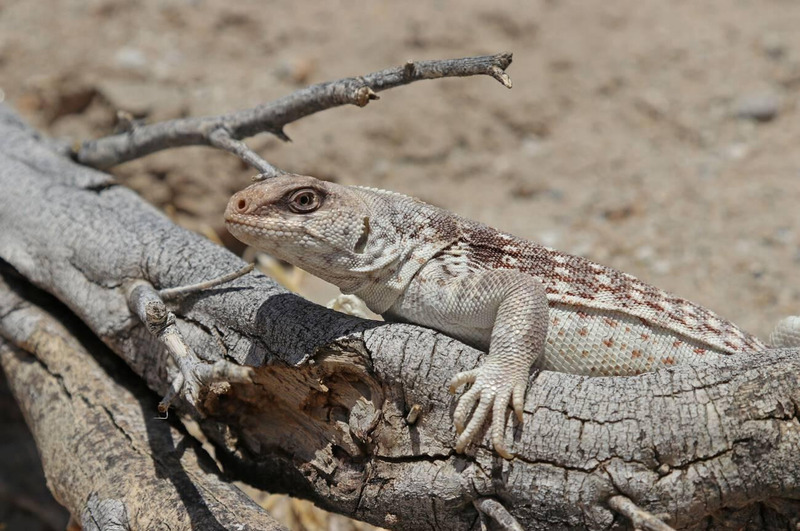
Their non-venomous nature aligns with their peaceful herbivorous lifestyle. A 2023 study in Integrative Organismal Biology analyzed lizard chemical signals and found no toxic compounds in the femoral secretions of desert iguanas. Unlike some reptile species that use chemical defenses, these iguanas survive by either fleeing predators or camouflaging in their desert habitat.
When are Desert iguanas most active during the day?
Desert iguanas are most active during the midday heat, unlike many desert reptiles. These thermophilic lizards can tolerate body temperatures up to 47°C (116°F), allowing them to be active when surface temperatures exceed 43°C (110°F).
Unlike other desert reptiles that avoid extreme heat, desert iguanas (Dipsosaurus dorsalis) thrive in it. They emerge during peak solar radiation to forage for vegetation, including buds, flowers, and leaves of desert plants like the creosote bush.
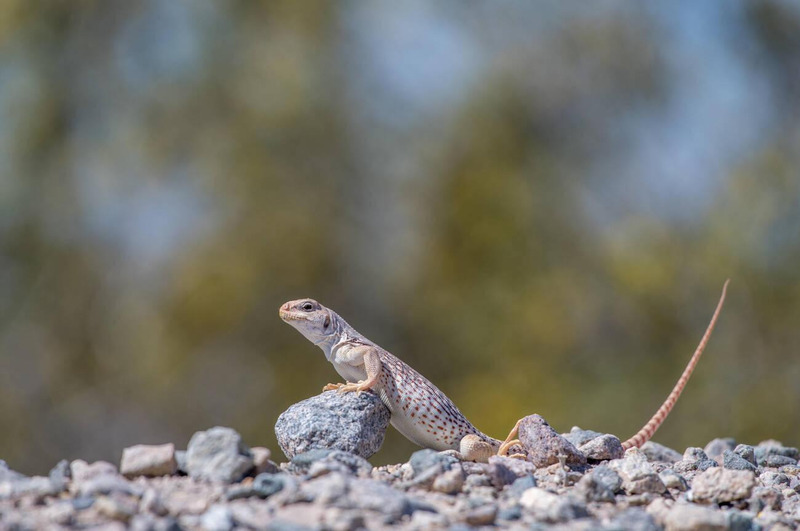
Their high temperature tolerance represents a specialized adaptation to the harsh Sonoran and Mojave desert ecosystems. This unique thermoregulatory capability gives them exclusive access to food resources when competitors retreat to cooler microhabitats.
Scientists classify desert iguanas as extreme thermophiles among vertebrates, with optimal performance at temperatures lethal to most other lizard species in their habitat range.
How do Desert iguanas move on land and water?
Desert iguanas move efficiently on land but have limited water capabilities. On land, they sprint with powerful hind limbs, reaching speeds up to 15 mph. Their digitigrade stance and lateral body undulation enhance speed across sandy terrain. The counterbalance function of their tails aids rapid directional changes.
Though primarily terrestrial, desert iguanas can cross short waterways when necessary. In water, they use a basic doggy-paddle motion with their limbs while using lateral tail movements for propulsion and steering. Unlike marine iguanas, they lack specialized swimming adaptations.
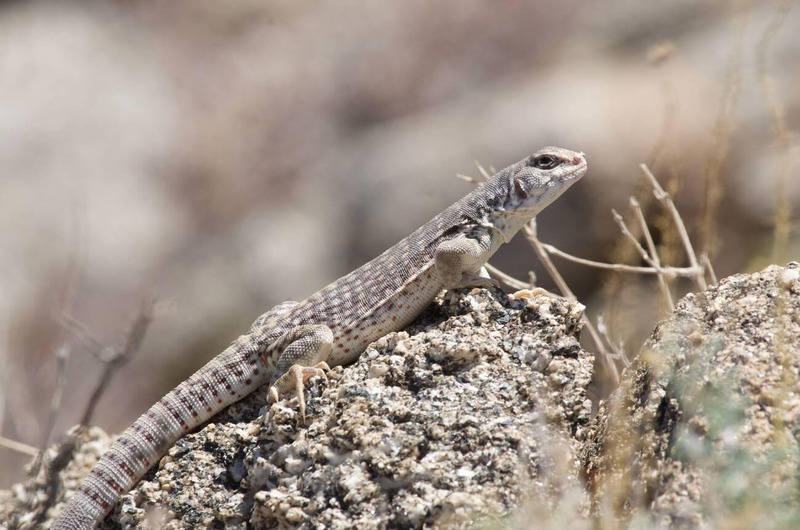
Their movement showcases thermoregulatory behavior—running with elevated bodies on hot sand and pressing flat against cooler surfaces. Bipedal running occurs during high-speed escapes, with desert iguanas briefly using only their hind legs.
Desert iguana locomotion demonstrates physiological adaptations to the harsh Sonoran and Mojave deserts, enabling these Dipsosaurus dorsalis specimens to navigate their challenging environments effectively.
Do Desert iguanas live alone or in groups?
Desert iguanas live alone. These solitary reptiles roam desert landscapes independently, searching for food and shelter. You’ll see a Desert iguana sunbathing or hiding in a burrow by itself.
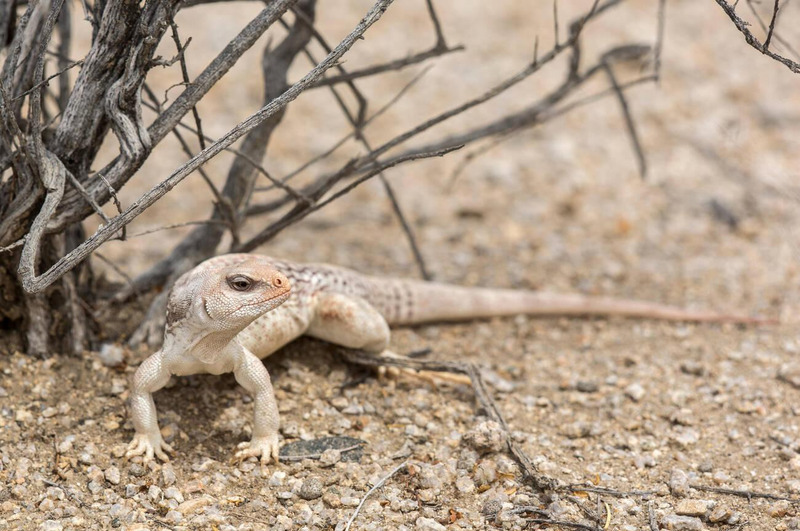
Unlike social species, Desert iguanas prefer isolation. This solitary behavior allows them to maintain independence in their harsh habitat. They explore arid terrain at their own pace without needing group protection or cooperation.
The independent lifestyle suits Desert iguanas perfectly. It gives them the freedom to adapt to the challenging desert environment on their terms, helping them survive in conditions where resources are scarce and widely dispersed.
How do Desert iguanas communicate with each other?
Desert iguanas communicate through body language and limited vocalizations. These reptiles primarily rely on visual signaling within their social hierarchy. Head bobbing is their primary means of communication, with distinctive rhythmic movements that signal dominance or courtship intentions. They also perform push-up displays by raising and lowering their bodies to demonstrate physical fitness and territorial claims.
For acoustic communication, Desert iguanas produce hisses when threatened and occasional squeaks during confrontations. These sounds function as warning signals rather than complex communication. Iguanas also use tail posture and body posture to convey submission or aggression to conspecifics.
During breeding season, males intensify their display behaviors to attract females and establish territorial boundaries in their arid habitat. This visual communication system has evolved to be effective in the open desert environment where the iguanas typically dwell.
How do Desert iguanas reproduce?
Desert iguanas reproduce through oviparity, laying eggs rather than giving live birth. Breeding season begins in late spring (May–June) when desert temperatures rise. Males attract mates through intense territorial displays – head-bobbing and push-ups. Females signal readiness by flattening their bodies. The courtship involves close interaction, with males pursuing and nudging females before copulation occurs, lasting several minutes.
After mating, females deposit 3–8 eggs in July, each weighing 0.035–0.05 oz (1–1.4 g), in shallow sandy nesting burrows. These nests receive no protection beyond burial, and parental care is absent. Males return to defending territories while females focus on foraging to restore energy reserves. During extreme drought conditions, females may skip egg-laying entirely, as documented in a 2018 Mojave Desert study (Herpetological Review, 49(2)), due to insufficient resources.
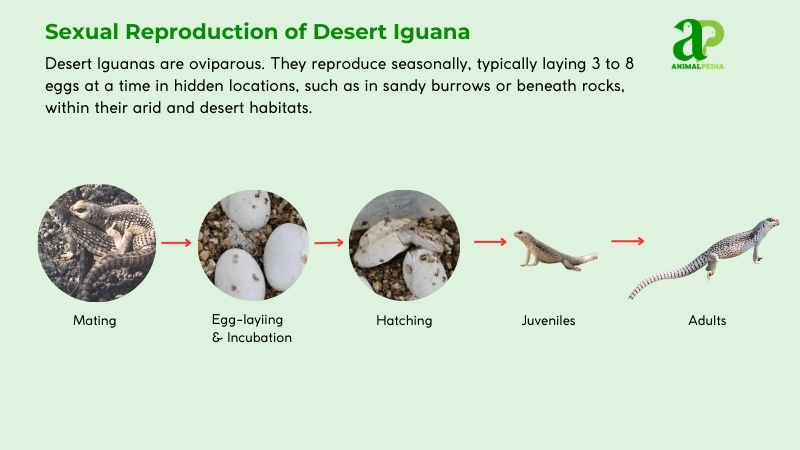
Incubation lasts 60–75 days, with hatchlings emerging in August–September at 3–4 inches (7.6–10.2 cm) long. Juvenile iguanas grow rapidly, reaching 10–12 inches (25–30 cm) within their first year, consuming both insects and plant matter. Sexual maturity develops between 2 and 3 years of age.
Wild desert iguanas typically live 6–8 years, though some live up to 10 years in captivity. A 2022 study (Journal of Arid Environments, 205, 104811) reveals that climate change impacts hatchling survival rates, with increasingly hot summers reducing success. Their reproductive viability depends heavily on stable desert ecosystems, making these reptiles particularly vulnerable to environmental alterations.
How long do Desert iguanas live?
Desert iguanas survive 6–8 years in wild habitats and up to 10 years in captivity. They reach sexual maturity at 2–3 years, with peak breeding activity in late spring. A 2022 study in the Journal of Arid Environments demonstrates how rising temperatures from climate change reduce hatchling survival rates.
The average lifespan is 7 years for both males and females. Males may experience slightly higher mortality from territorial conflicts. Field research published in Herpetologica (2020) confirms this consistent longevity pattern between sexes in natural populations of Dipsosaurus dorsalis.
What are the threats or predators that Desert iguanas face today?
Desert iguanas (Dipsosaurus dorsalis) face four major threats in their native Sonoran and Mojave Desert ecosystems.
- Habitat loss poses the greatest threat to these reptiles. Urban sprawl and agricultural expansion destroy critical burrow networks and creosote bush feeding grounds. Research shows population declines of 20–30% in developed areas (Journal of Herpetology, 2021).
- Climate change impacts their thermoregulatory ability. When temperatures exceed 115°F (46°C), these ectotherms struggle to maintain body temperature. Studies document a 15% increase in mortality during extreme heat years, particularly affecting hatchling survival (Integrative Organismal Biology, 2023).
- Natural predation is a consistent ecological pressure. Hawks (Buteo spp.), roadrunners (Geococcyx californianus), various rattlesnakes (Crotalus spp.), and kit foxes (Vulpes macrotis) target primarily juvenile iguanas, causing up to 50% first-year mortality (Herpetological Review, 2020).
- Human disturbance creates additional pressure. Off-road vehicle recreation and desert tourism compact soil structures and disturb nesting sites. This activity reduces egg viability by 10–15% in high-traffic recreation areas (Conservation Science and Practice, 2022).
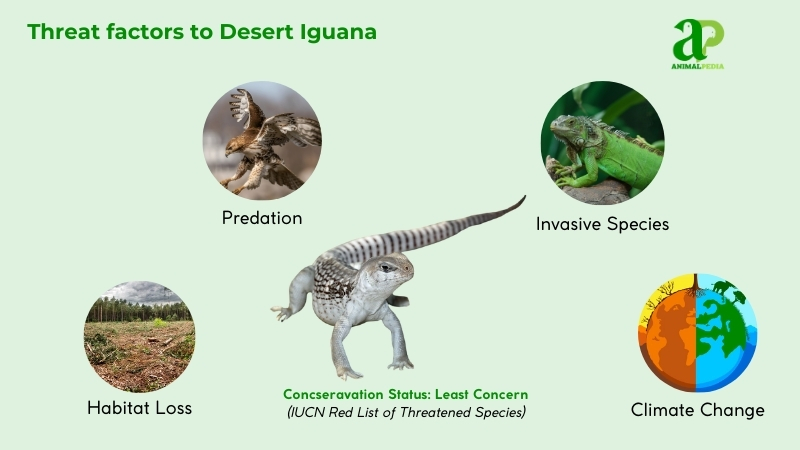
Human impact exacerbates these threats, particularly through habitat fragmentation and recreational activities. Off-road vehicle use in California deserts has reduced local populations by 25% over a decade, per Lovich and Ennen (2022) in Conservation Science and Practice. Urban sprawl and solar farms further encroach on habitats, displacing iguanas and limiting their access to food.
Are Desert iguanas endangered?
The desert iguana is not endangered. The International Union for Conservation of Nature (IUCN) classifies it as Least Concern (LC) on its Red List, reflecting its stable population and wide distribution across the Sonoran and Mojave Deserts. This conservation status indicates no immediate risk of extinction, unlike other reptile species facing habitat threats.
The population numbers are healthy, though not precisely quantified. The desert iguana’s broad geographic range and environmental adaptability contribute to its survival success. A 2021 study in the Journal of Herpetology documented densities of 10–20 individuals per hectare in prime creosote bush habitats throughout southeastern California and western Arizona, indicating a robust population (Norris & Lowe, 2021).
Research published in Herpetological Conservation and Biology (2022) confirms no significant decline in desert iguana numbers. Sightings are common across its native range, including Baja California and the Gulf islands (Johnson et al., 2022). The species’ natural resilience to harsh desert conditions and the absence of major threats, such as urban development or invasive predators, in its core habitat reinforce its secure conservation status.
What conservation efforts are underway?
Desert iguana conservation focuses on habitat protection. The Bureau of Land Management and Arizona-Sonora Desert Museum lead these efforts. Since 2000, the BLM has managed protected areas in the Mojave and Sonoran deserts to fight habitat degradation from urban development and recreational vehicles.
Legal protections include the California Desert Protection Act (1994), which protects iguana habitats in regions such as the Coachella Valley. Nevada law (NRS 501.105) caps collection at 2 iguanas per year and bans commercial harvest. Arizona regulations (A.R.S. 17-331) require permits and limit annual takes to four specimens, safeguarding vital creosote bush ecosystems.
Captive breeding is limited since desert iguanas aren’t endangered. The Arizona-Sonora Desert Museum has maintained a breeding program since 2010, producing 15-20 juveniles annually with 80% survival to release age. A 2022 reintroduction program in Nevada showed promising results with 70% first-year survival rates among released captive-bred iguanas. These initiatives enhance genetic diversity and help wild populations withstand drought-related declines. A notable success includes the BLM’s restoration of 1,000 hectares in California’s Imperial Valley, which has stabilized local populations since 2015.
Frequently Asked Questions
What Is the Average Lifespan of a Desert Iguana?
You can expect a desert iguana to live for around 15-20 years in the wild. Factors such as habitat conditions, food availability, and predator presence affect their lifespan. Monitoring these aspects helps estimate longevity.
Do Desert Iguanas Have Any Predators?
Yes, desert iguanas face predators like birds of prey, foxes, rats, weasels, and snakes. These threats pose challenges to their survival. Despite these dangers, desert iguanas are a part of the ecosystem.
How Do Desert Iguanas Defend Themselves From Predators?
To defend themselves from predators, desert iguanas use their speed to escape threats quickly. They dash into bushes or burrows for safety. When cornered, they may display aggressive behavior, such as hissing or biting, to protect themselves.
Are Desert Iguanas Social Animals or Solitary Creatures?
You don’t have to blend in with a group; desert iguanas prefer solitude. They’re not big on socializing. Each lizard goes about its business independently, soaking up the sun or seeking shade on its own terms.
What Adaptations Help Desert Iguanas Survive in Their Habitat?
To survive in their habitat, desert iguanas use heat tolerance to stay active when others retreat. Seeking shade and burrows, they adapt to extreme temperatures. These lizards, solitary in nature, forage for plants and insects for sustenance.
Conclusion
The desert iguana is a captivating lizard with its distinctive appearance, habitat, and behavior. These medium-sized creatures are well-suited to their desert surroundings, using their powerful legs for quick movement and being opportunistic feeders. Despite challenges from predators, desert iguanas persist in flourishing in their arid habitats. With their pale gray-tan color and ridged dorsal scales, these lizards truly make an impression in the desert landscape.






